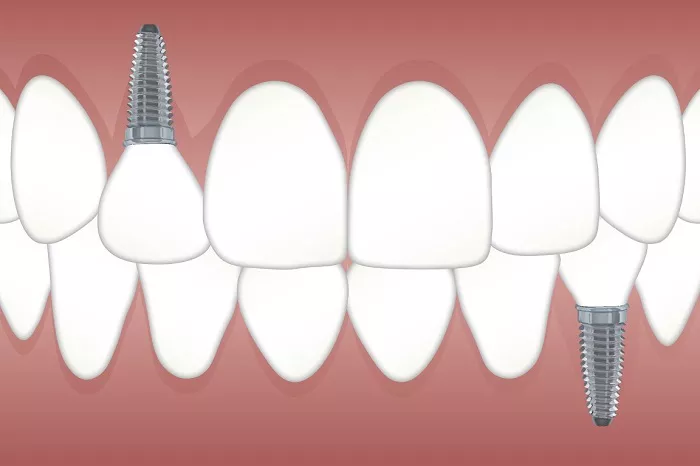In the field of dentistry, the question of whether dental implants are as strong as real teeth is a common and important one. As dental implants have become a popular solution for replacing missing teeth, understanding their strength and functionality in comparison to natural teeth is crucial for patients considering this treatment option.
The Structure and Function of Real Teeth
Real teeth are remarkable biological structures. The crown, the visible part above the gum line, is covered with enamel, the hardest substance in the human body. This enamel provides a strong protective layer, allowing teeth to withstand the forces of biting and chewing. Beneath the enamel is the dentin, which is slightly softer but still contributes to the overall strength of the tooth. The root of the tooth is embedded in the jawbone and is connected to it through the periodontal ligament.
This ligament acts as a shock absorber, allowing for a certain degree of flexibility while also firmly anchoring the tooth in place. Natural teeth work in harmony with the surrounding tissues and the jaw joint to perform various functions such as biting, tearing, and grinding food.
The Composition and Design of Dental Implants
Dental implants are typically made of titanium, a biocompatible material that has the ability to integrate with the jawbone. The implant consists of a screw-like post that is surgically placed into the jawbone, mimicking the root of a natural tooth.
Over time, the bone fuses with the implant through a process called osseointegration, creating a stable foundation. Once the implant has integrated, an abutment is attached, which serves as a connector for the final restoration, usually a crown. The crown is custom-made to match the color, shape, and size of the patient’s natural teeth, providing an aesthetically pleasing appearance.
Strength in Biting and Chewing Forces
Initial Stability:
Immediately after implantation, the implant has a certain level of stability due to its mechanical fixation in the bone. However, it is not yet as strong as a natural tooth. During the osseointegration period, which can take several months, the implant gradually gains strength as the bone grows and bonds with it. Once fully integrated, dental implants can withstand significant biting and chewing forces. Studies have shown that they can handle forces similar to those of natural teeth, although the exact amount may vary depending on factors such as the quality of the bone, the position of the implant, and the patient’s overall oral health.
Long-Term Durability:
Over the long term, dental implants have proven to be highly durable. With proper care and maintenance, they can last for many years, even a lifetime in some cases. The titanium implant is resistant to corrosion and wear, and the crown restoration is made to be strong and durable.However, it’s important to note that excessive forces, such as those from habits like grinding or clenching teeth, can potentially damage the implant or its components. Patients are often advised to wear a nightguard if they have a history of bruxism to protect the implant and the surrounding teeth.
Adaptability and Sensitivity
Lack of Natural Sensitivity:
One significant difference between dental implants and real teeth is the lack of natural sensitivity. Real teeth have a complex network of nerves that allow us to feel sensations such as hot, cold, and pressure. This sensitivity can act as a warning sign for potential damage or decay. Dental implants, on the other hand, do not have this natural nerve supply.
While this means that patients do not experience toothaches in the traditional sense, it also requires them to be more vigilant in maintaining good oral hygiene and attending regular dental check-ups to detect any potential problems early.
Adaptability to Occlusal Changes:
Natural teeth have the ability to adjust and move slightly in response to changes in the bite or the forces exerted on them. This adaptability is due to the periodontal ligament, which allows for a small degree of tooth movement. Dental implants, being rigidly fixed in the bone, do not have this same level of adaptability. Therefore, it is crucial that the implant is placed in the correct position and that the occlusion (the way the teeth come together) is carefully adjusted during the restoration process. If the occlusion is not properly balanced, it can lead to excessive forces on the implant and the surrounding teeth, potentially causing damage over time.
Maintenance and Care
Oral Hygiene:
Maintaining good oral hygiene is essential for the longevity and strength of both real teeth and dental implants. For natural teeth, brushing at least twice a day and flossing regularly helps remove plaque and prevent tooth decay and gum disease. Dental implants also require similar care. Patients should use a soft-bristled toothbrush and a non-abrasive toothpaste to clean the implant and the surrounding gums. Special flossing tools or interdental brushes may be recommended to reach areas around the implant.
Regular Dental Check-ups:
Real teeth benefit from regular dental check-ups, which allow the dentist to detect and treat any problems such as cavities or gum disease early. The same is true for dental implants. During these check-ups, the dentist will examine the implant for signs of loosening, infection, or damage to the crown. X-rays may be taken to assess the bone levels around the implant and ensure that osseointegration is maintained. Any necessary adjustments or repairs can be made promptly to keep the implant functioning optimally.
Conclusion
In conclusion, dental implants are designed to closely mimic the function and strength of real teeth. While they may not have all the exact characteristics of natural teeth, such as natural sensitivity and adaptability, they offer a highly effective and durable solution for replacing missing teeth. With proper surgical placement, careful occlusal adjustment, and diligent maintenance, dental implants can provide patients with a strong and reliable replacement that allows them to chew, speak, and smile with confidence.

